Mary M. Jackson | |
|---|---|
 Jackson in 2017 | |
| Born | 1966 (age 56–57) Spain |
| Allegiance | |
| Service/ | |
| Years of service | 1984–2020 |
| Rank | |
| Commands held | |
| Awards | |
Mary Marcella Jackson [1] (born 1966) [2] is a retired United States Navy officer.
Mary M. Jackson | |
|---|---|
 Jackson in 2017 | |
| Born | 1966 (age 56–57) Spain |
| Allegiance | |
| Service/ | |
| Years of service | 1984–2020 |
| Rank | |
| Commands held | |
| Awards | |
Mary Marcella Jackson [1] (born 1966) [2] is a retired United States Navy officer.
Mary Jackson graduated from high school in Wimberley, Texas and her Navy biography list her as a native. [3] However, she was born in Spain and spent 15 years of her life in Saudi Arabia as a child. [4] Her father was a US Army Air Corps officer during World War II and also a geologist. Jackson decided to become an oceanographer at an early age and chose to study with the Navy to save on tuition fees. [5] She graduated from the US Naval Academy in 1988 with a bachelor of science degree in physics, but particularly specialised in oceanography. She was awarded a post graduate degree in engineering management from George Washington University. [3]
Jackson became a surface warfare officer in 1989. She served on board ships in the Atlantic and Pacific fleets. This included stints as assistant operations officer and navigator with fleet replenishment ship USS Willamette and as operations officer on the destroyer USS Briscoe and guided missile cruiser USS Vella Gulf. Jackson was executive officer on the guided missile destroyer USS Stout before receiving her first command, the guided missile destroyer USS McFaul. The McFaul was the flagship of Combined Task Force Iraqi Maritime and Destroyer Squadron 50. [3]
Jackson has also served as a navigation and seamanship instructor at the Naval Academy and as theater air and missile defense officer with Joint Forces Command. She was flag secretary to the commander of naval surface forces, chief of staff to the commander of the mid-Atlantic region and has held positions with Navy Personnel Command. Jackson has also been executive officer and commander of Naval Station Norfolk. Jackson commanded Navy Region Southeast from July 18, 2014 to February 23, 2017. [3] She was appointed vice admiral and commander of Navy Installations Command in April 2017, responsible for all of the US Navy's on-shore infrastructure – 71 installations on almost one million acres of land. She was promoted directly from the one-star rank of Rear admiral (lower half) to three-star rank. [6] She relinquished command of Navy Installations in May 2020 and was awarded the Distinguished Service Medal. [7]

USS Mustin (DDG-89) is an Arleigh Burke-class guided missile destroyer in the United States Navy. She is named in honor of the Mustin family who has devoted over a century of US Naval service. This ship is the 39th destroyer of her class. Mustin was the 18th ship of this class to be built at Ingalls Shipbuilding in Pascagoula, Mississippi, and construction began on 15 January 2001. She was launched on 12 December 2001 and was christened on 15 December 2001. On 26 July 2003, a twilight commissioning ceremony was held at the Naval Air Station North Island in San Diego, California.

Arthur LeRoy Bristol, Jr. was a vice admiral in the United States Navy, who held important commands during World War I and World War II, and was an early aircraft carrier commander.

The United States Fleet Forces Command (USFF) is a service component command of the United States Navy that provides naval forces to a wide variety of U.S. forces. The naval resources may be allocated to Combatant Commanders such as United States Northern Command (USNORTHCOM) under the authority of the Secretary of Defense. Originally formed as United States Atlantic Fleet (USLANTFLT) in 1906, it has been an integral part of the defense of the United States of America since the early 20th century. In 2002, the Fleet comprised over 118,000 Navy and Marine Corps personnel serving on 186 ships and in 1,300 aircraft, with an area of responsibility ranging over most of the Atlantic Ocean from the North Pole to the South Pole, the Caribbean Sea, Gulf of Mexico, and the waters of the Pacific Ocean along the coasts of Central and South America.

USS Mahan (DDG-72) is an Arleigh Burke-class destroyer currently in service with the United States Navy. This ship is the 22nd destroyer of her class. USS Mahan was the 12th ship of this class to be built at Bath Iron Works in Bath, Maine, and construction began on 17 August 1995. She was launched and christened on 29 June 1996. On 14 February 1998 she was commissioned in Tampa, Florida. Mahan is homeported in Norfolk, Virginia, and as of 2012 was attached to Destroyer Squadron 2. By 2016, the ship was part of Destroyer Squadron 22.

Joseph Mason "Bull" Reeves was an admiral in the United States Navy and an early and important supporter of U.S. Naval Aviation. Though a battleship officer during his early career, he became known as the "Father of Carrier Aviation" for his role in integrating aircraft carriers into the fleet as a major part of the Navy's attack capabilities.

Admiral John Lesslie Hall Jr. was a senior officer of the United States Navy, who served during World War II.

Rear Admiral Wayne Eugene Meyer is regarded as the "Father of Aegis" for his 13 years of service as the Aegis Weapon System Manager and later the founding project manager of the Aegis Shipbuilding Project Office. He retired from the United States Navy in 1985 as the Deputy Commander for Weapons and Combat Systems, Naval Sea Systems, Naval Sea Systems Command and Ordnance Officer of the Navy.
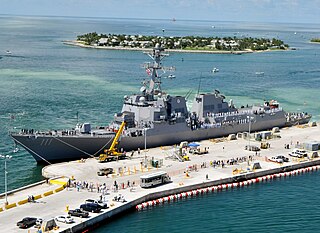
USS Spruance (DDG-111) is a United States Navy Arleigh Burke-class destroyer. She is the 61st ship in her class. Spruance is the second ship to be named for Admiral Raymond A. Spruance (1886–1969), who commanded American naval forces at the Battles of Midway and the Philippine Sea. He was later Ambassador to the Philippines. Her keel was laid down on 14 May 2009. She was christened by the admiral's granddaughter, Ellen Spruance Holscher, on 5 June 2010 in Bath, Maine at Bath Iron Works, where the ship was built at a cost of $1 billion. The completed ship left Bath on 1 September 2011 for her commissioning in Key West, Florida on 1 October 2011.

Harold Webster Gehman Jr. is a retired United States Navy four-star admiral who served as NATO's Supreme Allied Commander, Atlantic (SACLANT), Commander-in-Chief of the United States Joint Forces Command, one of the United States' Unified Combatant Commands, and Vice Chief of Naval Operations. He was also the Co-Chairman of the Commission that investigated the terrorist attack on the USS Cole and was Chairman of the Columbia Accident Investigation Board (CAIB) after the Space Shuttle Columbia disintegrated during reentry in 2003, killing all seven crew members.

John Collins Harvey Jr. is a former United States Navy four-star admiral who last served as the 31st Commander, United States Fleet Forces Command from July 24, 2009 to September 14, 2012. He previously served as Director, Navy Staff (N09B) from March 24, 2008 to July 23, 2009. Prior to that, he served as the 54th Chief of Naval Personnel and Deputy Chief of Naval Operations (N1) from November 2005 to April 2008. He retired from the navy after more than 39 years of service.
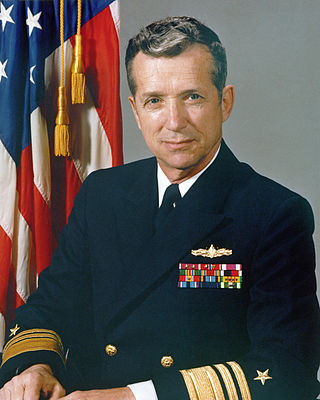
Joseph Metcalf III was a United States Navy vice admiral. He graduated from Vermont Academy in 1946 and then from the Naval Academy in 1951 and retired from active duty in 1987.
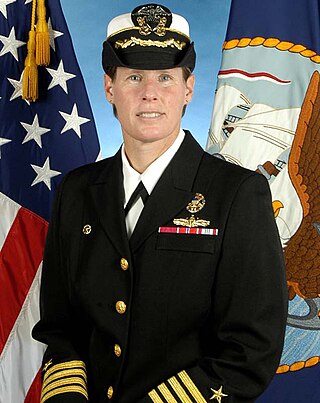
Holly Ann Graf is a retired United States Navy officer. Until January 2010 she was commanding officer of the Ticonderoga-class guided missile cruiser USS Cowpens (CG-63), a major surface combatant vessel of the fleet. She was the first woman to command a cruiser in the history of the U.S. Navy. Earlier, she had been the first woman in the U.S. Navy to command a destroyer when she served as skipper of the guided missile destroyer USS Winston S. Churchill (DDG-81). Her personal decorations include the Legion of Merit and the Bronze Star, among others. Graf was relieved of command for abusive behavior unbecoming of an officer and was featured in Time magazine that characterized her as a modern-day female "Captain Bligh". The U.S. Navy forced Graf into early retirement in 2012, but allowed her to do so at her current rank of captain and under "honorable circumstances".
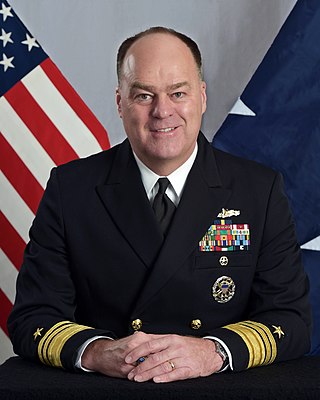
John Nels Christenson is a retired vice admiral in the United States Navy who last served as the United States Military Representative to the NATO Military Committee, in Brussels, Belgium. He was the 53rd President of the Naval War College in Newport, Rhode Island from March 2011 to July 2013.

Benedict Joseph Semmes Jr. was a vice admiral of the United States Navy. His career included service in World War II and the Cold War, command of destroyers, a lengthy tour as Chief of Naval Personnel, command of the United States Second Fleet, duty as Deputy Chief of Naval Operations, and a tour as President of the Naval War College.

Jacob Lawrence Shuford was a rear admiral of the United States Navy. His career included service in the Cold War, Kosovo War, and Operation Desert Fox. He commanded surface combatants, served on the staffs of the Chief of Naval Operations, the Joint Chiefs of Staff, and the Secretary of the Navy, coordinated Navy legislative activities in the United States Senate, and his final assignment as President of the Naval War College.

Admiral William John Flanagan Jr. is a retired United States Navy four star admiral who served as Commander in Chief, United States Atlantic Fleet from 1994 to 1996.
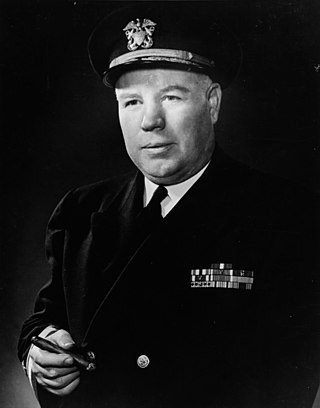
Vice Admiral Edmund Battelle Taylor was an admiral in the United States Navy. During World War II he saw service in the fighting in the Pacific, including the Battle of Cape Esperance, in which his ship, the USS Duncan was sunk, the Battle of Empress Augusta Bay and the Battle of the Philippine Sea. In the last months of the war he was the naval aide to the Secretary of the Navy, James Forrestal. After the war he commanded the Guantanamo Bay Naval Base and was commander of the Antisubmarine Defense Force, Atlantic Fleet, during the Cuban Missile Crisis.

William Rhode Merz is a retired United States Navy vice admiral who last served as deputy chief of naval operations for operations, plans and strategy from August 6, 2021 to October 7, 2022. He previously served as commander of U. S. Seventh Fleet from 2019 to 2021.
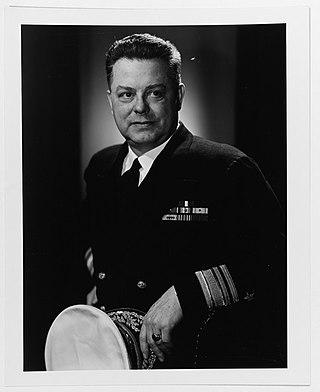
Willard Augustus Kitts III was a highly decorated officer in the United States Navy with the rank of Vice Admiral. An ordnance expert and veteran of several campaigns in the Pacific Theater during World War II, he distinguished himself as Commanding officer of heavy cruiser USS Northampton, which was sunk during the Battle of Tassafaronga in November 1942.

John Vincent Fuller is a United States Navy vice admiral who serves as the 42nd Naval Inspector General since June 11, 2021. Prior to that, Fuller served as deputy director for force protection of the Joint Staff and before that as the director of strategy, plans, and policy of the United States Northern Command.